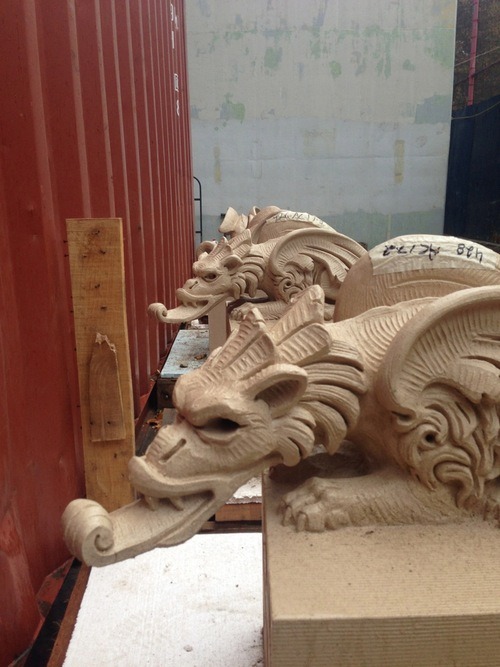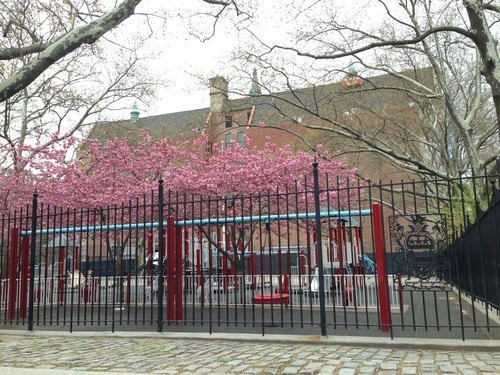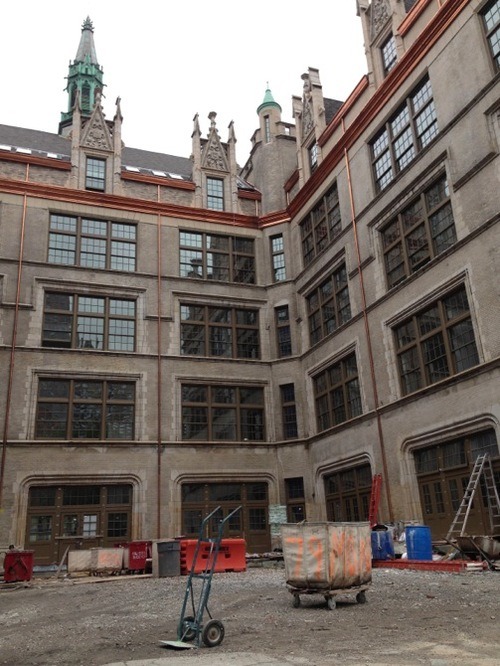Spotlight: PS109, A Live/Work Artspace Project in East Harlem
ANNOUNCING A CALL FOR APPLICATIONS
Artspace is a leading non-profit organization providing affordable art spaces to communities throughout the United States. Recently, the organization completed its first facility in New York City—Artspace PS109. PS109, a former abandoned public school building in East Harlem, offers 90 units of affordable live/work space to artists and their families; also available on the ground floor and lower level are 3,000 square feet for a resident gallery, and 10,000 square feet of non-residential space for arts and cultural organizations.
Qian Xu speaks to Shawn McLearen, VP of Property Development, about what PS109 brings to New York City artists and the East Harlem community where it is located.
NYFA: Artspace is opening a new facility in East Harlem PS109. In addition to affordable housing, what else will the new space offer to future artist and non-artist residents?
SM: Across the country, the artists who live and work out of our spaces report that the opportunities we create help them become more productive, receive greater recognition, and ultimately earn more money from their artistic work. Affordable housing, cultural space and community are the foundations of those opportunities, but that is just the beginning. We expand living space to also include work space. We turn hallways into galleries and open the building for regular art-walk events. We create gallery, performing, and meeting spaces for use by residents, organizations, and community members alike.
The other key piece of our model is that we offer stability. No matter what else happens in East Harlem, Artspace guarantees that PS109 will remain affordable and dedicated to artists for generations to come. You can find reports and publications about these important issues on our website: www.artspace.org/ideas-insights.
NYFA: The development of PS109 seems to have been informed in part by discussions with community organizations and community and local leaders. Were there any cultural or social needs in East Harlem that proved to be a particular challenge for Artspace to address during the planning of the space?
SM: Each project that Artspace is invited to develop has a unique challenge and opportunity matrix built into its DNA. Therefore, a big part of our job is to slow the real estate process down enough to facilitate partnerships around a long-term development agenda that reinforces the cultural assets of a community.
While there are many similarities to the underlying model that we bring to bear in our partnerships across the country (e.g., need for sustainable cultural infrastructure; need for affordable live/work space for artists, their families, and local organizations; limited capital resources; opportunity for inter-agency partnerships; opportunity for inter-sector capital resources; etc.), there are also unique conditions within every local cultural ecosystem that have to be understood and cultivated through a process.
Here in El Barrio, that process was led by a partnership with El Barrio’s Operation Fightback (a local CDC with 30 years experience in El Barrio), with Speaker Melissa Mark-Viverito, Community Board 11, NYC Department of Housing Preservation and Development, NYC Department of Cultural Affairs, and many, many more. [The partnership] provided clarity on a number of issues important to the local community: they wanted the historic PS109 building preserved rather than demolished; they wanted to provide mixed/community use rather than private/commercial-use; and they preferred affordable housing and community facilities rather than condos or commercial space.
It was also clear that there were significant cultural assets and leaders that needed to remain part of the process if we were all going to be successful in bringing the project online as a community facility. Artspace won’t take a project on if these key commitments don’t exist.
NYFA: Although PS109 is open to anyone who qualifies for low-income housing and meets certain income requirements, there is an emphasis on applicants who participate in and are committed to the arts. Does this include arts administrators and others working in the field, in addition to artists?
SM: Yes. We take a big-umbrella approach to the proposition and encourage all to apply. We’ve learned from experience around the country that cultural ecosystems are diverse, and that local leadership has made our organization stronger in helping us understand that diversity. By extension, we know how important arts administrators and others working in the field are to the success of arts and culture in NYC.
NYFA: Artists who apply will be reviewed by a community-based selection committee that will evaluate their commitment to their art rather than the quality of work. Can you elaborate on the concept of an artist’s commitment and how it will be gauged by the committee?
SM: In creating an Artist Selection Committee, we always look for a mix of local artists who represent a diversity of disciplines, ages, genders, and ethnicities. It is also critical that the committee members themselves are not applying for residency, which could create a conflict of interest. With a good mix, identifying artists is really not that hard: artists know artists. Rather than focusing on the slippery and divisive question of excellence, we find it much more valuable to focus on artists who have demonstrated a sustained commitment to their craft people we know will make the greatest use of the opportunities we create. In addition, living in an Artspace property is a different kind of experience, and we want to find artists who will thrive in a community-centric space, who will participate in planning committees, and who will help PS109 as a whole develop as a community anchor. We want to be sure that each applicant is treated consistently and fairly, so the committee asks the same exact questions of each applicant. It’s up to the artist to provide a sense of that commitment in a holistic, tangible way. There’s no magic answer. It’s pretty human stuff at the end of the day. We have more information about this process on our website, at: www.artspace.org/about/frequently-asked-questions

NYFA: Who comprises the committee (e.g, local artists, community leaders)? Should artists craft an application that speaks to a general audience or a panel of their peers?
SM: We need to be clear that the application for housing is separate and distinct from the Artist Selection Committee interview. Artspace projects are government-regulated affordable housing, and the applications are strictly regulated and based on verifiable facts, such as income, credit, and other standard factors. Applicants who qualify on those factors and self-identify as artists are then invited to meet with the Artist Selection Committee. The committee for a new project is made up of a mix of local artists, as outlined above, and Artspace staff.
The first round of the multi-step application process will be a lottery system. Assuming someone is selected through that process, what should they know and be prepared for in round two?
SM: Following the lottery, applications will be reviewed for completeness and income qualification. There are several preferences in addition to being an artist that will come into play during this process. Using the HPD model, there are preferences for current residents of Community Board 11; for visually-, hearing-, and mobility-impaired applicants; and for employees of the City. Those applicants that meet all the criteria and identify themselves as artists will then be invited to meet with the Artist Selection Committee. The Committee will approve qualified artists until all the units have been filled.
NYFA: PS109 will feature space for exhibitions, offices for non-profits, and other flexible multipurpose space. How much of this will be accessible for use by non-resident community members? How often will activities, events, and shows be available to non-residents?
SM: The simple answer is as much as possible, as often as possible. The harder answer is that it usually takes one of our projects a few years to get to its own unique cruising altitude and its own unique rhythm. PS109 has 114,00 square feet that will hold 90 live/work units and approximately 20,000 square feet of non-residential, programmatic space. The 20,000 square feet is made up of everything from administrative offices to exhibition space, “community commons,” and courtyards designed to handle events. At times the entire building will light up like some of the gallery walks in Chelsea; at other times, it may be one of the organizations holding an event, or a community group holding a meeting. Whatever it is, it’ll be PS109.

NYFA: Artspace has properties in more than 30 communities nationwide, but PS109 is the only community currently in New York City. Will there be other projects in New York?
SM: My feeling is that there will be other projects in New York. As wonderfully complicated and fulfilling as this project has been, providing 90 units of live/work space to our community is only the tip of the iceberg. As Project Director of PS109, I’m proud of what PS109 represents as evidence of community development partnerships and the capacity of local leadership to chart a course and bring it online. I’m also convinced that our collective ability to do so on time and on budget will allow those partnerships to point at PS109 and-hopefully-see that the real product is the model, and decide to incentivize other developers to do the same so that we can all make an even greater impact on the crisis facing our creative sector.
Clearly, the fact that Mayor de Blasio included PS109 as a case study in his ten-year housing plan is extremely encouraging. But when you consider DCA Commissioner Finkelpearl’s commitment to both affordability for artists and community engagement, as well as the leadership that Speaker Viverito has shown on PS109, then you have an extraordinary opportunity for the kind of inter-agency partnerships that make projects like PS109 possible. We’re honored to be a partner to the City and convinced that NY can build progressive policies that would have significant impact around the country.
NYFA: Outside of New York, what are some upcoming Artspace plans and projects?
SM: Currently we have about 15 other projects in various stages of development. These projects include projects as diverse as the conversion of a vacant, two-block school campus in the heart of New Orleans Tremé neighborhood to a mobile arts lab on the Pine Ridge Reservation in South Dakota. We are working in El Paso, Memphis, Chicago, and elsewhere. What drives all of this work is the continuing need for artists to find and preserve quality, affordable space, coupled with a recognition that dynamic artistic communities help build more livable cities. You can learn more about this growing family at: www.artspace.org/our-places
For more information about PS109 and the other spaces that Artspaces offers to artists, visit the Artspace website.
To find additional information about live/work spaces, visit NYFA Source and run the following queries:
– Service: Space/Equipment/Materials (Access & Information)
– Award(s): Space Awards (Live and/or Work)
Live/works opportunities are also available on NYFA Classifieds’ Space Directory.
— INTERVIEW CONDUCTED BY QIAN XU
Images, from top: PS109 under construction with new windows and copper drains; restored architectural detail: the terra cotta gargoyles; PS109 as seen through the adjacent park. All photographs by Shawn McLearen.



